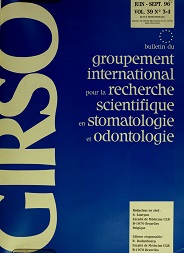Immunomorphological characteristics of pleomorphic adenoma of salivary glands
Keywords:
salivary glands, pleomorphic adenoma, immunohistochemistryAbstract
The immunohistochemical profile of 23 pleomorphic adenomas and 7 normal salivary glands was studied. We used antisera to vimentin (V), desmin (D), epithelial membrane antigen (EMA), prostate specific antigen (PSA), pancytokeratin, carcinoembryonic antigen (CEA), glial fibrillary acidic protein (GFAP) and S-100 protein. In the ducts and myoepithelial cells of normal salivary glands immunopositivity to most of the cytoskeletal proteins, EMA and CEA was observed. GFAP was localized only in cells of striated ducts. Major differences in the expression of various antigens among tubular structures, solid sheets, the myxoid and chondroid in the pleomorphic adenoma were encountered. Appearance of GFAP as a sign of stromal transformation into myxoid and chondroid was detected.
Judging from these comparative immunohistochemical characteristics between normal salivary glands and pleomorphic adenomas, we assume that tumour cells originate from the reserve cells of intercalated and striated ducts.
Downloads
Published
Issue
Section
License
I hereby certify that the authors of the above manuscript have all:
1. Conceived, planned, and performed the work leading to the report, or interpreted the evidence presented, or both;
2. Written the report or reviewed successive versions and shared in their revisions; and
3. Approved the final version.
Further, I certify that:
1. This work has not been published elsewhere and is not under revision in another journal;
2. Humane procedures have been followed in the treatment of experimental animals (if applicable);
3. Investigations in humans was done in accordance with the ethical standards of the responsible committee on human experimentation or with the Helsinki Declaration (if applicable).
4. This paper has been carefully read by a native English speaker who is familiar with the field of work (this applies to authors who are not fluent in English); and
5. The copyright of the article is transferred from the authors to the Bulletin du Groupement International pour la Recherche Scientifique en Stomatologie et Odontologie upon acceptance of the manuscript.



